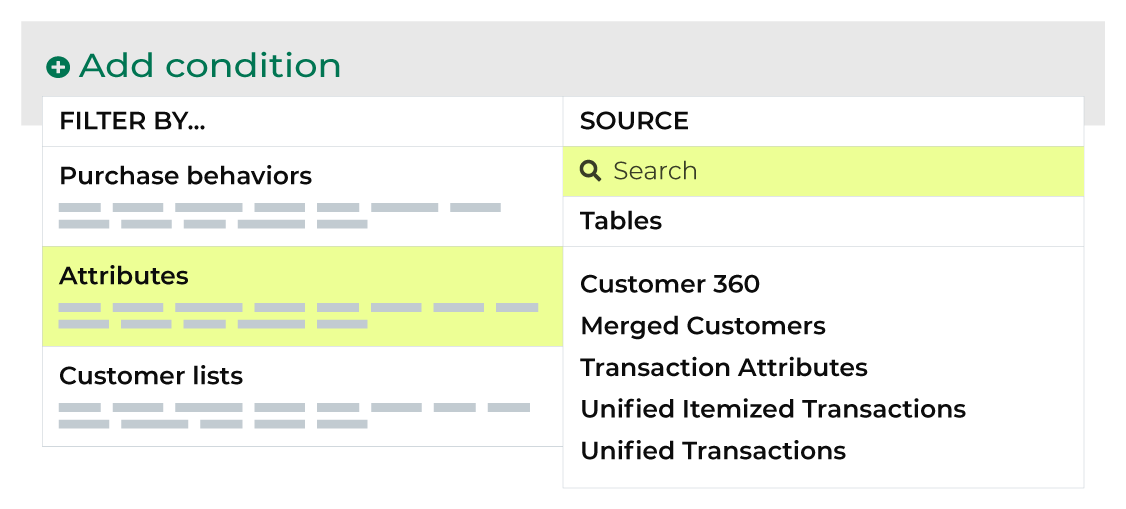Store visit intervals¶
Use store visit attributes to build segments that support many types of campaigns. Store visit attributes are available in 30-day, 3-month, 6-month, 12-month, 1-year, and lifetime intervals.
You can access store visit interval attributes directly from the Segment Editor:
L30D Stores (30 days)
L3M Stores (3 months)
L6M Stores (6 months)
L12M Stores (12 months)
LY12M Stores (12-to-24 months)
Lifetime Stores (Lifetime)
You can add store visits interval attributes to a segment from the Segment Editor. Click Add condition, and then choose Attributes.

Enter “stores” into the search feature to filter the list of available attributes. Choose an interval to add the attribute to a segment. Select an operator, and then finish defining the conditions for how this attribute should be applied to the segment.
Available operators¶
The following table lists the operators that are available to store visit interval attributes.
Note
Store visit interval attributes have an Integer data type. All Integer data types share the same set of operators. Recommended operators for this attribute are identified with “ More useful” and operators with more limited use cases are identified with “ Less useful”.
Operator |
Description |
|---|---|
is |
Returns customer records with values that match the specified number of items in the interval. |
is between |
More useful Returns customer records with values that are between the specified number of items in the interval. For example: if is between is set to 10 and 20, then customer records with at least 11 (but not more than 19) total items will be returned. |
is greater than |
More useful Returns customer records with values that are greater than the specified number of items in the interval, not including the specified number of items. For example: if is greater than is set to 10, then customer records with 11 (or more) total items will be returned. |
is greater than or equal to |
Returns customer records with values that are greater than or equal to the specified number of items in the interval, including the specified number of items. For example: if is greater than or equal to is set to 10, then customer records with 10 (or more) total items will be returned. |
is in list |
Returns customer records with values that match the number of items in the interval that are specified in a list. |
is less than |
More useful Returns customer records with values that are less than the specified number of items in the interval, not including the specified number of items. For example: if is less than is set to 20, then customer records with 19 (or fewer) total items will be returned. |
is less than or equal to |
Returns customer records with values that are less than or equal to the specified number of items in the interval, including the specified number of items. For example: if is less than or equal to is set to 20, then customer records with 20 (or fewer) total items will be returned. |
is not |
Less useful Returns customer records with values that do not match the specified number of items in the interval. |
is not between |
Less useful Returns customer records with values that are not between the specified number of items in the interval, not including the specified number of items. For example: if is not between is set to 12 and 24, then customer records with at least 25 (but not more than 11) total items will be returned. |
is not in list |
Less useful Returns customer records with values that do not match the number of items in the interval that are specified in the list. |
is not NULL |
Returns customer records that have a value. |
is NULL |
Returns customer records that do not have a value. |
